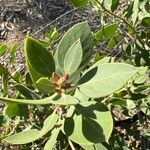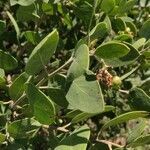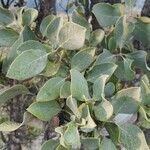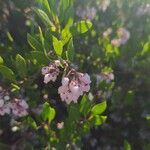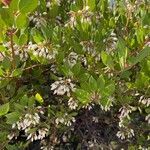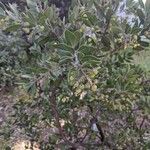Shrubs or trees, erect, 2-8 m; burl absent or prominent, globose; twigs glabrous, sparsely short-hairy, or glandular-hairy. Leaves: petiole 6-12 mm; blade bright green or glaucous, shiny or dull, widely ovate or oblong-ovate to obovate, 2-5 × 1-3.5 cm, base rounded to ± cuneate, margins entire, plane, surfaces smooth or scabrous, puberulent or veins finely hairy . Inflorescences panicles, 3-7-branched; immature inflorescence ± abruptly deflexed, branches spreading, axis 1.5-4.5 cm, 1+ mm diam., glabrous, sparsely short-hairy, or sparsely glandular-hairy, not viscid; bracts not fully appressed, scalelike, deltate, 2-4 mm, apex mucronate or acuminate, surfaces glabrous or sparsely hairy to finely glandular-hairy. Pedicels 3-8 mm, glabrous. Flowers: corolla white, conic to urceolate; ovary glabrous or minutely stipitate glandular-hairy. Fruits depressed-globose, 8-12 mm diam., hairy or glabrous, stipitate-glandular or smooth. Stones distinct, sometimes connate.
More
A shrub. It grows to 2.4-4.5 m high. It is stiff and woody. It can be spreading. The bark is reddish brown. There can be peeling layers of older duller bark. The leaves are thick and oval. There is a white scurf over the leaf when young. The leaves are 5 cm long. The flowers are tiny and in tight clusters. They are urn shaped and deep pink. The fruit are white but become red-brown berries. These are 12 mm across.
Dry coastal slopes and in canyons up to 1,200 metres. Oak woodlands, chaparral, and open conifer forests; at elevations from sea level to 1,500 metres.
More
It is a warm temperate plant. It can tolerate long dry periods. It is resistant to frost. It suits hardiness zones 8-10.
